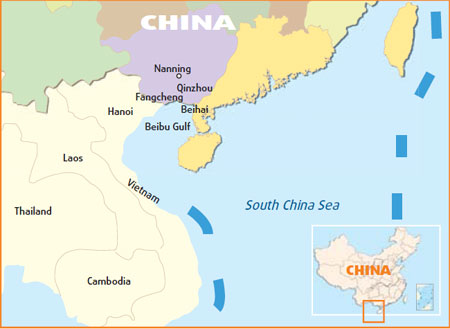

|
An overseas-registered vessel unloads cargo at Qinzhou Port of Guangxi Zhuang autonomous region. |
Once the battlefront of a decade-long war between China and Vietnam, stagnating within a mountainous backwater, the Guangxi Zhuang autonomous region is now fast becoming the next front of China's development, and a significant forerunner in regional cooperation with China's Southeast Asian neighbors.
It is well positioned to do so. Located north of Beibu Gulf in the South China Sea, Guangxi was the starting point of the ancient sea Silk Road that connected China with Southeast Asia, Africa and Europe. Beihai, one of its three major port cities, was also among the first 13 Chinese coastal cities opened for foreign trade in the early 1980's.
Despite the China-Vietnam border conflict from the late 1970s to 1980s that brought enormous economic losses to the region, Guangxi has now grown from the bitter memories and shadow of gunfire.
The booming border trade across the China-Vietnam border is the best testimony that past grievances and hostility have given way to ever-strengthening economic ties.
Moreover, as China steps up its economic and trade cooperation with the Southeast Asian nations under the China-ASEAN Free Trade Agreement (FTA), the region is ready to take advantage of its geographical location to both develop its economy and promote China's regional integration with the ASEAN.
Gateway to the ASEAN
In January this year, China's State Council approved the Guangxi Beibu Gulf Economic Development Plan (2006-2020), which covers Beihai, Qinzhou and Fangchenggang, the three coastal cities, as well as the capital city Nanning, as part of its commitment to boost the development of the region and China's economic cooperation with the ASEAN.
Under the plan, the region will serve as the logistics, trade, and processing base as well as an information exchange center for the China-ASEAN free trade zone.
This is also part of a wider cooperative mechanism in the Pan Beibu Gulf economic cooperation involving China and Southeast Asia.
As the biggest trading partner for Guangxi, ASEAN's trade volume with the region reached $2.9 billion last year, accounting for more than one third of Guangxi's total foreign trade. Despite the current economic crisis, trade volume between the two still increased by 67 percent year-on-year in the first nine months of this year, according to Ma Biao, chairman of Guangxi.
"Under the development plan, Guangxi will serve as an important region for promoting international economic cooperation," says Ma. "This represents unprecedented opportunities for us to become the next economic belt in China after the Pearl and Yangtze river deltas and Bohai Economic Circle."
Now, along Guangxi's beautiful coast line, a new industrial landscape is emerging quickly as testimony to the opportunities ahead.
PetroChina, China's largest oil producer, is building a 10-million-ton-a-year oil refinery in Qinzhou. The new refining facility will process oil from Sudan, where PetroChina's parent company China National Petroleum Corp (CNPC) produced 16.38 million tons of crude oil and found new reserves of 78.6 million tons last year.
Expected to be launched by the end of 2009, the refinery will benefit from the huge market demand in southwestern China by easing the shortage of oil products there, says Li Libin, project director at the Guangxi branch of the oil company.
By processing imported crude oil directly at Qinzhou and serving the local markets, PetroChina would be able to cut its transportation costs substantially as compared with the past when it has to transfer processed oil products from the north to south.
The city is also constructing China's sixth bonded port zone to better serve as the gateway for China-ASEAN cooperation. First-phase construction is expected to wrap up by the end of next year, while major international logistics companies like Denmark-based Maersk have already shown great interest in having their presence there, says He Zhen, director of Qinzhou's Beibu Gulf development project.
At the neighboring city Fangchenggang, China's fourth largest iron and steel producer Wuhan Iron and Steel has formed a joint venture with Guangxi Liuzhou Iron and Steel to build a huge steel base there. With a production capacity of 10 million tons a year, the project has already been approved by China's top economic planner and will provide rolled steel to southwest and southern China, and the ASEAN countries as well.
The city also aspires to become an international shipping center. Home to the biggest port in western China with a designed capacity of over 200 million tons a year and more than 180 deep-water berths, Fangchenggang handled 50 million tons of throughput last year and is expected to go beyond 60 million tons by the end of this year.
Statistics from Guangxi's communications bureau show that ports in Guangxi achieved a total throughput of 72 million tons during the first 10 months of this year, a 21.4 percent increase year-on-year.
Environmental protection
The development of these projects will not come at the cost of the environment, backers say. Ma says Guangxi should make the best out of its environment, protect it and make sure it will remain as the region's major competitive edge.
He says environmental protection is high on the government's agenda and serves as an important barometer in the government's decisions.
Because the region is situated at the upper reaches of the Pearl River Delta, it has the responsibility to protect its environment, especially the water source, from polluting neighboring Guangdong province and Hong Kong as well.
To this end, the region has begun a large-scale "green crusade", from planting trees, and wastewater treatment to other citywide clean-up efforts.
"It is our hope that when investors come here for their project investment, they will also like the environment and consider it to be an ideal place to settle down," Ma says.

(China Daily 12/08/2008 page10)













